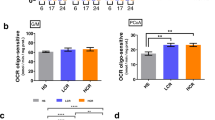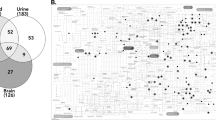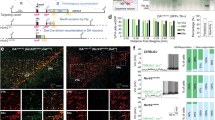Abstract
Metabolic function is integrally related to an individual's susceptibility to, and progression of, disease. Selective breeding for intrinsic treadmill running in rats has produced distinct lines of high- or low-capacity runners (HCR and LCR, respectively) that exhibit numerous physiological differences. To date, the role of intrinsic aerobic capacity on behavior and stress response in these rats has not been addressed and was the focus of these studies. HCR and LCR rats did not differ in their locomotor response to novelty or behavior in the light/dark box. In contrast, immobility in the forced swim test was higher in LCR rats compared with HCR rats, regardless of desipramine treatment. Although both HCR and LCR rats responded to cat odor with decreased exploration and increased risk assessment, HCR rats showed greater contextual conditioning to cat odor. HCR rats exhibited higher expression of corticotropin-releasing hormone in the central nucleus of the amygdala, as well as heavier adrenal and thymus weight. Corticosterone was comparable among HCR and LCR rats at light/dark transitions, and in response to unavoidable cat odor. HCR rats, however, exhibited a greater corticosterone response following the light/dark box. These experiments show that the LCR phenotype associates with decreased risk assessment in response to salient danger signals and passive coping. In contrast, HCR rats show a more naturalistic strategy in that they employ active coping and a more vigilant and cautious response to environmental novelty and salient danger signals. Within this context, we propose that intrinsic aerobic capacity is a central feature mechanistically linking complex metabolic disease and behavior.
Similar content being viewed by others
Log in or create a free account to read this content
Gain free access to this article, as well as selected content from this journal and more on nature.com
or
References
Akil H (2005). Stressed and depressed. Nat Med 11: 116–118.
Bale TL, Vale WW (2004). CRF and CRF receptors: role in stress responsivity and other behaviors. Annu Rev Pharmacol Toxicol 44: 525–557.
Barbato JC, Koch LG, Darvish A, Cicila GT, Metting PJ, Britton SL (1998). Spectrum of aerobic endurance running performance in eleven inbred strains of rats. J Appl Physiol 85: 530–536.
Bauer ME, Jeckel CM, Luz C (2009). The role of stress factors during aging of the immune system. Ann N Y Acad Sci 1153: 139–152.
Bjornebekk A, Mathe AA, Brene S (2005). The antidepressant effect of running is associated with increased hippocampal cell proliferation. Int J Neuropsychopharmacol 8: 357–368.
Blanchard DC, Blanchard RJ, Griebel G (2005). Defensive responses to predator threat in the rat and mouse. Curr Protoc Neurosci (Suppl 30): 8.19.1–8.19.20, Chapter 8, Unit 8, 19.
Blanchard DC, Griebel G, Blanchard RJ (2003). Conditioning and residual emotionality effects of predator stimuli: some reflections on stress and emotion. Progr Neuro-psychopharmacol Biol Psychiatry 27: 1177–1185.
Blanchard RJ, Flannelly KJ, Blanchard DC (1986). Defensive behavior of laboratory and wild Rattus norvegicus. J Comp Psychol 100: 101–107.
Bonnet F, Irving K, Terra JL, Nony P, Berthezene F, Moulin P (2005). Depressive symptoms are associated with unhealthy lifestyles in hypertensive patients with the metabolic syndrome. J Hypertens 23: 611–617.
Britton DR, Koob GF, Rivier J, Vale W (1982). Intraventricular corticotropin-releasing factor enhances behavioral effects of novelty. Life Sci 31: 363–367.
Britton KT, Morgan J, Rivier J, Vale W, Koob GF (1985). Chlordiazepoxide attenuates response suppression induced by corticotropin-releasing factor in the conflict test. Psychopharmacology 86: 170–174.
Buck BJ, Kerman IA, Burghardt PR, Koch LG, Britton SL, Akil H et al (2007). Upregulation of GAD65 mRNA in the medulla of the rat model of metabolic syndrome. Neurosci Lett 419: 178–183.
Burghardt PR, Fulk LJ, Hand GA, Wilson MA (2004). The effects of chronic treadmill and wheel running on behavior in rats. Brain Res 1019: 84–96.
Burghardt PR, Pasumarthi RK, Wilson MA, Fadel J (2006). Alterations in fear conditioning and amygdalar activation following chronic wheel running in rats. Pharmacol Biochem Behav 84: 306–312.
Chemelli RM, Willie JT, Sinton CM, Elmquist JK, Scammell T, Lee C et al (1999). Narcolepsy in orexin knockout mice: molecular genetics of sleep regulation. Cell 98: 437–451.
Dallman MF, Levin N, Cascio CS, Akana SF, Jacobson L, Kuhn RW (1989). Pharmacological evidence that the inhibition of diurnal adrenocorticotropin secretion by corticosteroids is mediated via type I corticosterone-preferring receptors. Endocrinology 124: 2844–2850.
Detke MJ, Rickels M, Lucki I (1995). Active behaviors in the rat forced swimming test differentially produced by serotonergic and noradrenergic antidepressants. Psychopharmacology 121: 66–72.
Dielenberg RA, McGregor IS (1999). Habituation of the hiding response to cat odor in rats (Rattus norvegicus). J Comp Psychol 113: 376–387.
Dielenberg RA, McGregor IS (2001). Defensive behavior in rats towards predatory odors: a review. Neurosci Biobehav Rev 25: 597–609.
Droste SK, Chandramohan Y, Hill LE, Linthorst AC, Reul JM (2007). Voluntary exercise impacts on the rat hypothalamic-pituitary-adrenocortical axis mainly at the adrenal level. Neuroendocrinology 86: 26–37.
Droste SK, Gesing A, Ulbricht S, Muller MB, Linthorst AC, Reul JM (2003). Effects of long-term voluntary exercise on the mouse hypothalamic-pituitary-adrenocortical axis. Endocrinology 144: 3012–3023.
Dunn AL, Trivedi MH, Kampert JB, Clark CG, Chambliss HO (2005). Exercise treatment for depression: efficacy and dose response. Am J Prev Med 28: 1–8.
Dunn AL, Trivedi MH, O'Neal HA (2001). Physical activity dose–response effects on outcomes of depression and anxiety. Med Sci Sports Exerc 33 (Suppl): S587–S597;discussion 510–609.
Falls WA, Fox JH, Macaulay CM (2009). Voluntary exercise improves both learning and consolidation of cued conditioned fear in C57 mice. Behav Brain Res 207: 321–331.
Foley TE, Greenwood BN, Day HE, Koch LG, Britton SL, Fleshner M (2006). Elevated central monoamine receptor mRNA in rats bred for high endurance capacity: implications for central fatigue. Behav Brain Res 174: 132–142.
Gonzalez NC, Howlett RA, Henderson KK, Koch LG, Britton SL, Wagner HE et al (2006). Systemic oxygen transport in rats artificially selected for running endurance. Respir Physiol Neurobiol 151: 141–150.
Greenwood BN, Foley TE, Burhans D, Maier SF, Fleshner M (2005). The consequences of uncontrollable stress are sensitive to duration of prior wheel running. Brain Res 1033: 164–178.
Greenwood BN, Strong PV, Dorey AA, Fleshner M (2007). Therapeutic effects of exercise: wheel running reverses stress-induced interference with shuttle box escape. Behav Neurosci 121: 992–1000.
Herring MP, O'Connor PJ, Dishman RK (2010). The effect of exercise training on anxiety symptoms among patients: a systematic review. Arch Intern Med 170: 321–331.
Hoffman MD, Hoffman DR (2008). Exercisers achieve greater acute exercise-induced mood enhancement than nonexercisers. Arch Phys Med Rehab 89: 358–363.
Hogg S, File SE (1994). Responders and nonresponders to cat odor do not differ in other tests of anxiety. Pharmacol Biochem Behav 49: 219–222.
Hussain SO, Barbato JC, Koch LG, Metting PJ, Britton SL (2001). Cardiac function in rats selectively bred for low- and high-capacity running. Am J Physiol Regul Integr Comp Physiol 281: R1787–R1791.
Kabbaj M, Devine DP, Savage VR, Akil H (2000). Neurobiological correlates of individual differences in novelty-seeking behavior in the rat: differential expression of stress-related molecules. J Neurosci 20: 6983–6988.
Kask A, Nguyen HP, Pabst R, Von Horsten S (2001). Neuropeptide Y Y1 receptor-mediated anxiolysis in the dorsocaudal lateral septum: functional antagonism of corticotropin-releasing hormone-induced anxiety. Neuroscience 104: 799–806.
Koch LG, Britton SL (2001). Artificial selection for intrinsic aerobic endurance running capacity in rats. Physiol Genom 5: 45–52.
Kopelman PG (2000). Obesity as a medical problem. Nature 404: 635–643.
Koponen H, Jokelainen J, Keinanen-Kiukaanniemi S, Kumpusalo E, Vanhala M (2008). Metabolic syndrome predisposes to depressive symptoms: a population-based 7-year follow-up study. J Clin Psychiatry 69: 178–182.
Korte SM, De Boer SF (2003). A robust animal model of state anxiety: fear-potentiated behaviour in the elevated plus-maze. Eur J Pharmacol 463: 163–175.
Koylu EO, Balkan B, Kuhar MJ, Pogun S (2006). Cocaine and amphetamine regulated transcript (CART) and the stress response. Peptides 27: 1956–1969.
Lu A, Steiner MA, Whittle N, Vogl AM, Walser SM, Ableitner M et al (2008). Conditional mouse mutants highlight mechanisms of corticotropin-releasing hormone effects on stress-coping behavior. Mol Psychiatry 13: 1028–1042.
Lujan HL, Britton SL, Koch LG, DiCarlo SE (2006). Reduced susceptibility to ventricular tachyarrhythmias in rats selectively bred for high aerobic capacity. Am J Physiol Heart Circ Physiol 291: H2933–H2941.
Masini CV, Sauer S, Campeau S (2005). Ferret odor as a processive stress model in rats: neurochemical, behavioral, and endocrine evidence. Behav Neurosci 119: 280–292.
Mastorakos G, Zapanti E (2004). The hypothalamic-pituitary-adrenal axis in the neuroendocrine regulation of food intake and obesity: the role of corticotropin releasing hormone. Nutr Neurosci 7: 271–280.
McEwen BS (2000). Allostasis and allostatic load: implications for neuropsychopharmacology. Neuropsychopharmacology 22: 108–124.
McEwen BS, Stellar E (1993). Stress and the individual. Mechanisms leading to disease. Arch Intern Med 153: 2093–2101.
McIntyre RS, Soczynska JK, Konarski JZ, Woldeyohannes HO, Law CW, Miranda A et al (2007). Should depressive syndromes be reclassified as ‘metabolic syndrome type II’? Ann Clin Psychiatry 19: 257–264.
Nemeroff CB, Widerlov E, Bissette G, Walleus H, Karlsson I, Eklund K et al (1984). Elevated concentrations of CSF corticotropin-releasing factor-like immunoreactivity in depressed patients. Science (New York, NY) 226: 1342–1344.
Noland RC, Thyfault JP, Henes ST, Whitfield BR, Woodlief TL, Evans JR et al (2007). Artificial selection for high-capacity endurance running is protective against high-fat diet-induced insulin resistance. Am J Physiol 293: E31–E41.
Novak CM, Escande C, Burghardt PR, Zhang M, Barbosa MT, Chini EN et al (2010). Spontaneous activity, economy of activity, and resistance to diet-induced obesity in rats bred for high intrinsic aerobic capacity. Horm Behav 58: 355–367.
Pentkowski NS, Litvin Y, Blanchard DC, Vasconcellos A, King LB, Blanchard RJ (2009). Effects of acidic-astressin and ovine-CRF microinfusions into the ventral hippocampus on defensive behaviors in rats. Horm Behav 56: 35–43.
Raikkonen K, Matthews KA, Kuller LH (2007). Depressive symptoms and stressful life events predict metabolic syndrome among middle-aged women: a comparison of World Health Organization, Adult Treatment Panel III, and International Diabetes Foundation definitions. Diabet Care 30: 872–877.
Richardson RD, Omachi K, Kermani R, Woods SC (2002). Intraventricular insulin potentiates the anorexic effect of corticotropin releasing hormone in rats. Am J Physiol 283: R1321–R1326.
Spencer RL, Kim PJ, Kalman BA, Cole MA (1998). Evidence for mineralocorticoid receptor facilitation of glucocorticoid receptor-dependent regulation of hypothalamic-pituitary-adrenal axis activity. Endocrinology 139: 2718–2726.
Tempel DL, Leibowitz SF (1994). Adrenal steroid receptors: interactions with brain neuropeptide systems in relation to nutrient intake and metabolism. J Neuroendocrinol 6: 479–501.
Van Hoomissen JD, Holmes PV, Zellner AS, Poudevigne A, Dishman RK (2004). Effects of beta-adrenoreceptor blockade during chronic exercise on contextual fear conditioning and mRNA for galanin and brain-derived neurotrophic factor. Behav Neurosci 118: 1378–1390.
Waters RP, Renner KJ, Pringle RB, Summers CH, Britton SL, Koch LG et al (2008). Selection for aerobic capacity affects corticosterone, monoamines and wheel-running activity. Physiol Behav 93: 1044–1054.
Weissman MM, Bland R, Joyce PR, Newman S, Wells JE, Wittchen HU (1993). Sex differences in rates of depression: cross-national perspectives. J Affect Disord 29: 77–84.
Wilhelm CJ, Mitchell SH (2009). Strain differences in delay discounting using inbred rats. Genes Brain Behav 8: 426–434.
Wisloff U, Najjar SM, Ellingsen O, Haram PM, Swoap S, Al-Share Q et al (2005). Cardiovascular risk factors emerge after artificial selection for low aerobic capacity. Science (New York, NY) 307: 418–420.
Yilmazer-Hanke DM, Faber-Zuschratter H, Linke R, Schwegler H (2002). Contribution of amygdala neurons containing peptides and calcium-binding proteins to fear-potentiated startle and exploration-related anxiety in inbred Roman high- and low-avoidance rats. Eur J Neurosci 15: 1206–1218.
Acknowledgements
This work was supported by NIH Grants No. P01 DA021633 to HA, No. 5T32HD007422-18, and No. UL1RR024986, and the Office of Naval Research Grant No. N00014-09-1-0598 to HA. The LCR and HCR rat resource was supported by Award R24RR017718 to SLB and LGK from the National Center for Research Resources (a component of the National Institutes of Health). We acknowledge the expert care of the rat colony provided by Molly Kalahar and Lori Gilligan.
Author information
Authors and Affiliations
Corresponding author
Ethics declarations
Competing interests
The authors declare no conflicts of interest.
Rights and permissions
About this article
Cite this article
Burghardt, P., Flagel, S., Burghardt, K. et al. Risk-assessment and Coping Strategies Segregate with Divergent Intrinsic Aerobic Capacity in Rats. Neuropsychopharmacol 36, 390–401 (2011). https://doi.org/10.1038/npp.2010.144
Received:
Revised:
Accepted:
Published:
Issue date:
DOI: https://doi.org/10.1038/npp.2010.144
Keywords
This article is cited by
-
Mitochondrial health is enhanced in rats with higher vs. lower intrinsic exercise capacity and extended lifespan
npj Aging and Mechanisms of Disease (2021)



